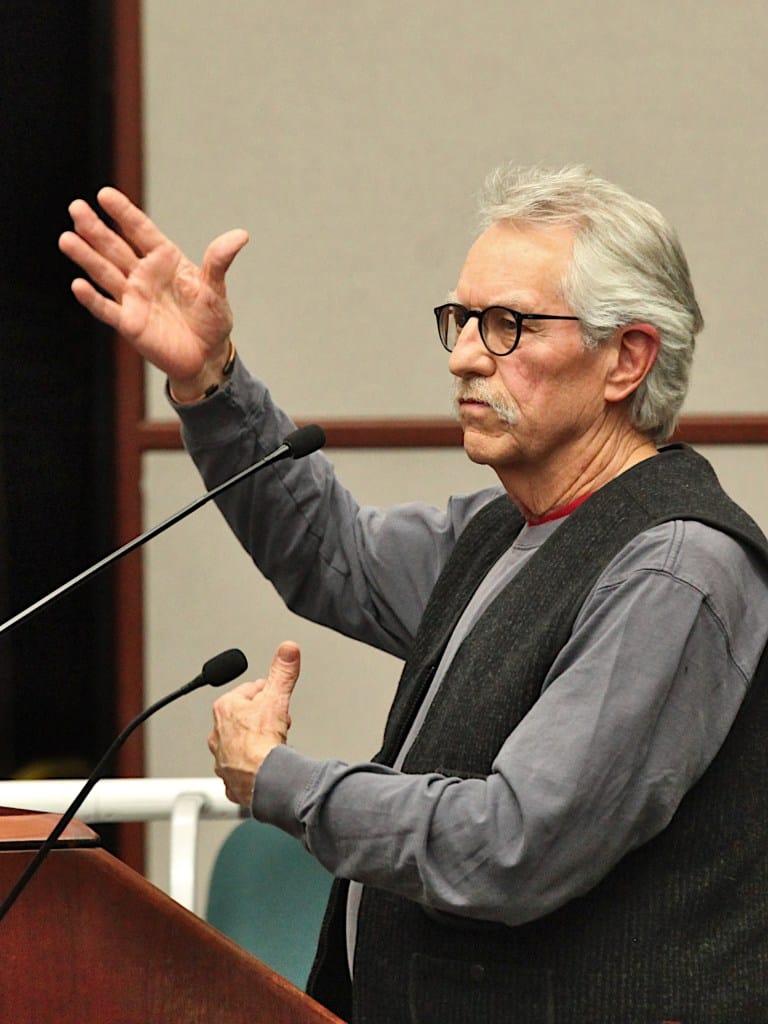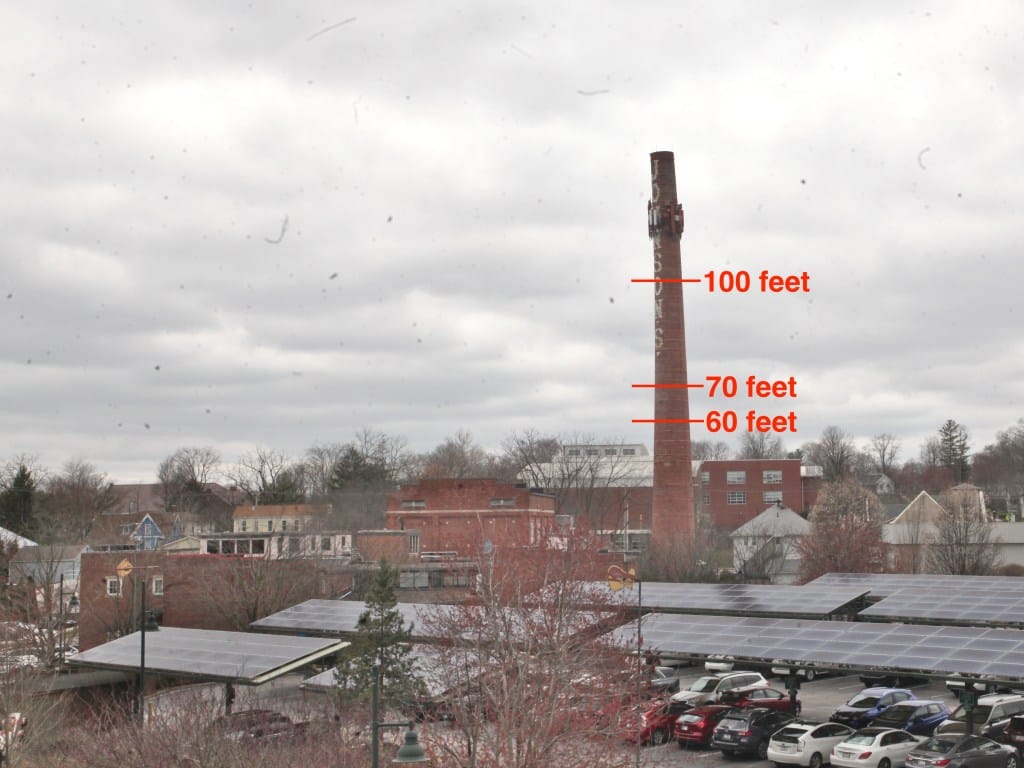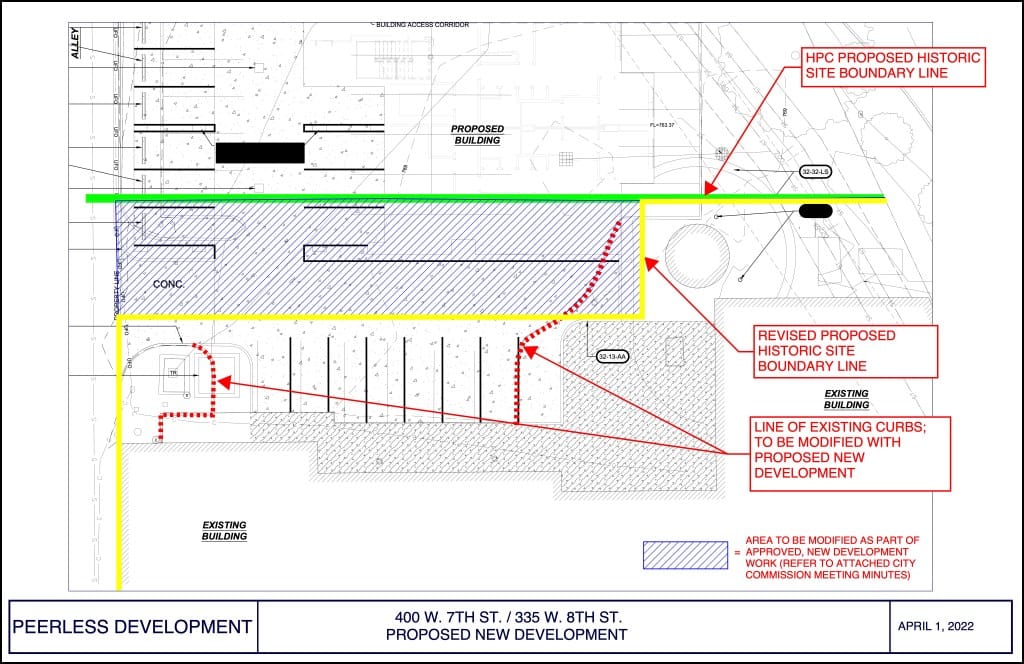Johnson’s Creamery building, 60 feet of smokestack get historic protection from Bloomington city council






The 140-foot Johnson’s Creamery smokestack will get demolished down to just 60 feet sometime in the next few weeks.
But it won’t get chopped down any shorter than that, because Bloomington’s city council has now enacted a historic district for the building, including its smokestack.
The Johnson’s Creamery is located on 7th Street just west of the B-Line Trail. The trail is temporarily closed where it runs past the smokestack out of a concern for public safety—because the smokestack is leaning and has been determined to be unsafe.
The council’s action came on a 9–0 vote at its regular meeting on Wednesday.
At its meeting last week. Bloomington’s historic preservation commission (HPC) went ahead and issued a certificate of appropriateness for the demolition of the smokestack down to 60 feet. The HPC’s action anticipated the council would establish a historic district for the building.
If the council had not enacted a historic district that included the smokestack, it could have been completely demolished.
That’s because the owner Peerless Development has been ordered by Bloomington’s housing and neighborhood development (HAND) department to reduce the height of the smokestack to no more than 60 feet.
The deadline for Peerless to reduce the smokestack’s height is 60 days from HAND’s March 11 demolition order. That works out to May 10.
The historic destination for the building was not controversial for councilmembers. The only question was where the boundary would be drawn.
Peerless has received approval to build a new residential development on the north half of the parcel.
Would the boundary include a small portion of that planned new residential development? No. The council settled on a boundary that was tweaked to run a bit southward from the one recommended by the HPC.
Bloomington’s historic preservation program manager, Gloria Colom presented the basic case for historic designation to the city council.
In the historic category, the Johnson’s Creamery building:
- Exemplifies the cultural, political, economic, social, or historic heritage of the community.
In the architectural category, the Johnson’s Creamery building:
- Owing to its unique location or physical characteristics, represents an established and familiar visual feature of the city; or
- Exemplifies the built environment in an era of history characterized by a distinctive architectural style
The boundary recommended by the HPC sliced the parcel in half—even though more typically a single-building historic district would include the whole parcel, according to Duncan Campbell, who’s an advisory member of the HPC.

Campbell was also responsible for renovating and restoring the Johnson’s Creamery building in the 1990s, and made the successful application for its inclusion in the National Register of Historic Places.
But during public commentary at Wednesday’s council meeting, Campbell advocated for a reduction in size to the recommended district, so that the new residential building would be excluded instead of being clipped by the district boundary.
At least three people spoke during public commentary against reducing the size of the historic district—Janice Sorby, Cynthia Bretheim, and William Coulter.
In support of maintaining the boundary as proposed by the HPC, as a kind of cautionary tale, Coulter showed the council five slides depicting the history of the Von Lee Theater on Kirkwood Avenue. Context is always important, Coulter said.
A larger district with the HPC-recommended boundary would have ensured that the look of the new residential development, part of the creamery’s context immediately to the north, would be under the control of the HPC.
The motion to move the boundary southward to exclude the new residential building was made by Isabel Piedmont-Smith. The boundary amendment was approved on an 8–1 vote. Dissenting was Dave Rollo.
Wednesday marked the conclusion to a series of meetings of the HPC and the city council about the smokestack, which had been prompted by HAND’s demolition order. The demolition order was based on a study of the structural integrity of the smokestack that was recently completed by Arsee Engineers.
During her public comment time on Wednesday, in support of historic protection for the smokestack, Natalia Galvan noted that the topic had taken up 15 hours of public meeting time.




Comments ()